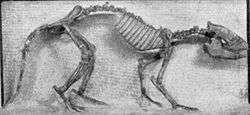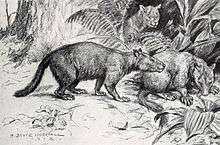Meniscotherium
| Meniscotherium Temporal range: Eocene | |
|---|---|
 | |
| Skeleton. | |
| Scientific classification | |
| Kingdom: | Animalia |
| Phylum: | Chordata |
| Class: | Mammalia |
| Order: | ?Perissodactyla |
| Family: | Phenacodontidae |
| Subfamily: | Meniscotheriinae |
| Genus: | Meniscotherium Cope, 1874 |
| Species | |
| |

Restoration of M. chamense
Meniscotherium is an extinct genus of dog-sized mammal which lived 54-38 million years ago. It was a herbivore and had hooves. Fossils have been found in Utah, New Mexico. and Colorado. Many individuals have been found together, indicating that it lived in groups.[1]
Body mass in M. chamense is estimated to be 5–17 kg, making it about the size of a small dog.[2]
A 2014 cladistic analysis places it within stem perissodactyls.[3]
References
- ↑ Thomas E. Williamson and Spencer G. Lucas. 1992. Meniscotherium (Mammalia, "Condylarthra") from the Paleocene-Eocene of western North America. Bulletin, New Mexico Museum of Natural History and Science. Albuquerque. 72 p.
- ↑ Dirks W. · Anemone R.L., Holroyd P.A., Reid D.J., (2009). "Phylogeny, Life History and the Timing of Molar Crown Formation in Two Archaic Ungulates, Meniscotherium and Phenacodus (Mammalia, 'Condylarthra')". Comparative Dental Morphology. 13: 3–8. doi:10.1159/000242381.
- ↑ Cooper, L. N.; Seiffert, E. R.; Clementz, M.; Madar, S. I.; Bajpai, S.; Hussain, S. T.; Thewissen, J. G. M. (2014-10-08). "Anthracobunids from the Middle Eocene of India and Pakistan Are Stem Perissodactyls". PLoS ONE. 9 (10): e109232. doi:10.1371/journal.pone.0109232. PMC 4189980
 . PMID 25295875.
. PMID 25295875.
This article is issued from Wikipedia - version of the 11/13/2016. The text is available under the Creative Commons Attribution/Share Alike but additional terms may apply for the media files.